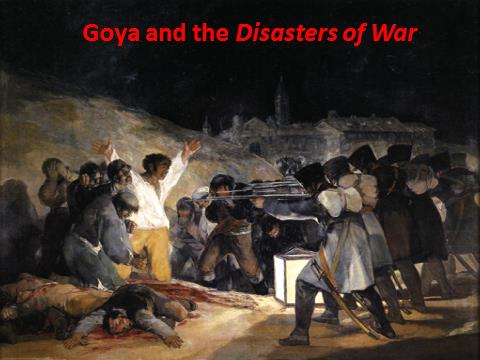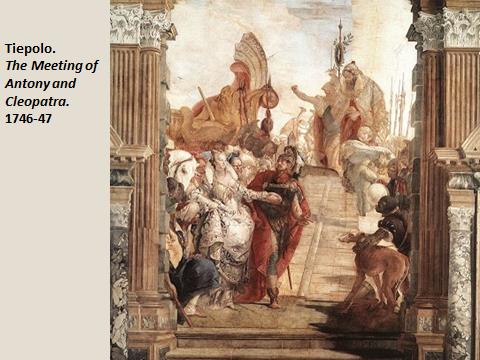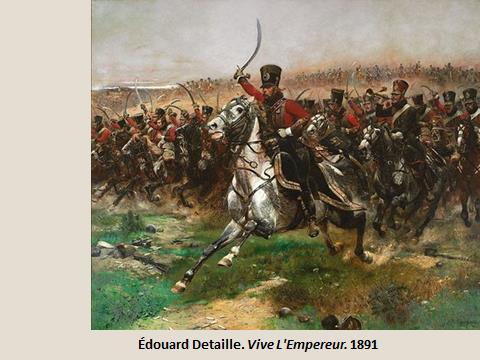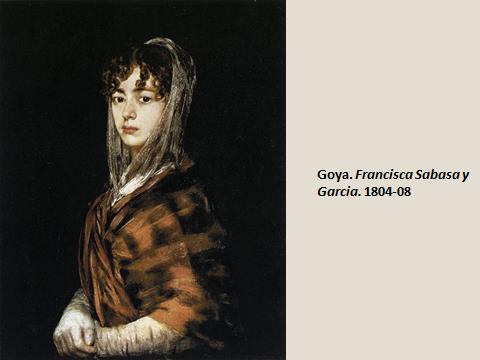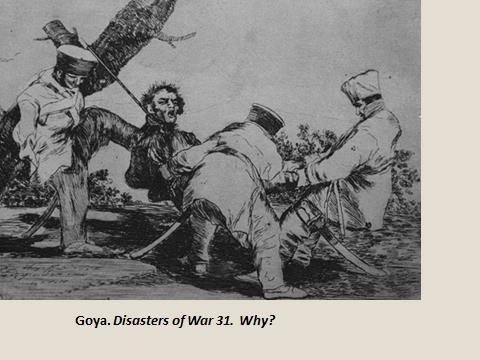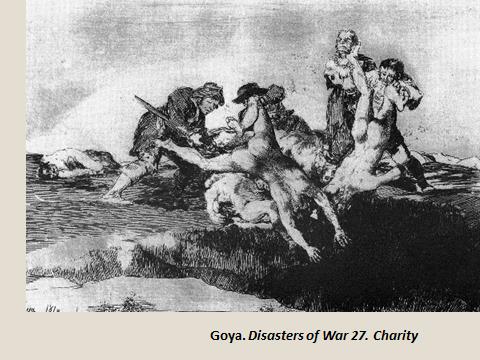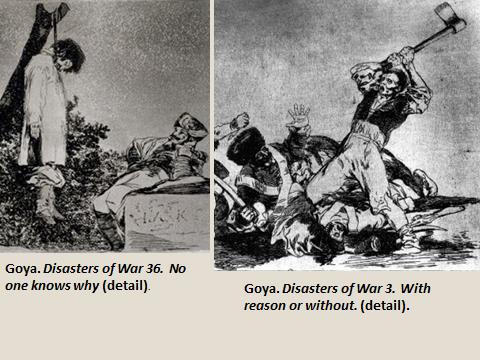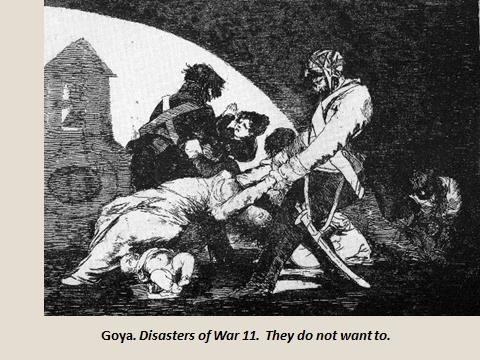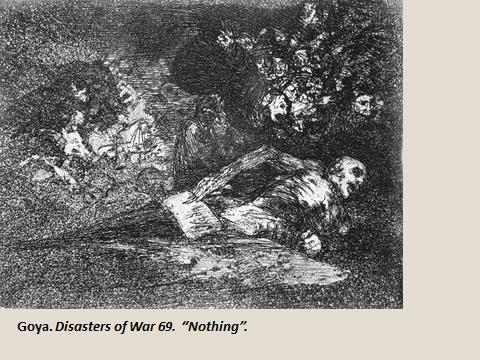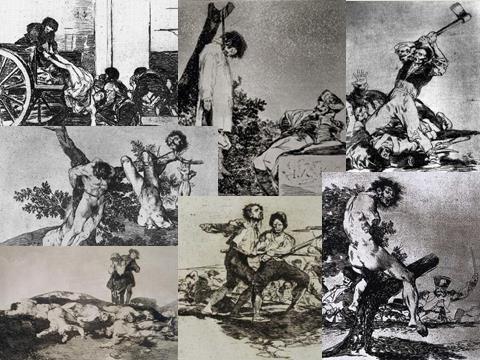Goya and the Disasters of War
War has certainly been
part of the “form and
pressure” of recent centuries but
it’s surprising when we reflect on it, how marginal the presence of war
has
often been in the art of those centuries, at least in any obvious
sense. Impressionism
is probably the most famous – or anyway the most popular – art movement
of the so-called
modern period, yet it’s hard even to imagine
a battle scene painted by Monet, Renoir or Pissarro. And Picasso’s Guernica aside, the art of the twentieth
century seems to have been much more preoccupied with harlequins and
everyday
objects than with scenes of war.
The focus in our
conference is not, however, the twentieth century, but the two
centuries
preceding it, and the artist I’d like to talk about is the Spanish
painter and
engraver, Francisco Goya, whose lifetime straddled the eighteenth and
nineteenth centuries. Goya’s art is fascinating in itself and he is, I
think,
rightly regarded as one of Europe’s greatest visual artists, but he is
of
particular interest to our conference because his works include some of
the
most powerful depictions of the disastrous human consequences of war in
the history of visual art.
Interestingly
enough, one would never suspect this if one looked only at his earlier
work. Goya
began as a typical artist of the eighteenth century, very much in the
vein of near
contemporaries such as Watteau, Tiepolo, and Fragonard, and the spirit
of his
paintings is, like theirs, a world away from the savage bloodletting of
the
battlefield.
War is almost
invisible in the works of the major artists the eighteenth century.
Admittedly,
it seems a somewhat less bellicose century that its predecessor, that
is, if we
exclude the French revolutionary wars that began in the 1790s; but the
eighteenth
century still had its wars – in both Europe and America – and men were
still
dying on battlefields or fearing they might. But the painters of the
period, like
most of the novelists, incidentally, do not seem to have been
interested.
Watteau invented his enchanting world of fetes
galantes; Tiepolo created a dazzling, theatrical realm full
of fantasy and
brilliance; Boucher
invited his viewer
into a world of voluptuous nymphs and cupids; Canaletto and Guardi
favoured
elegant Venetian scenes or picturesque ruins, and English painters such
as
Gainsborough seldom strayed from tasteful portraits of the titled or
the
well-to-do. Scenes of violence were not unknown, of course: religious
paintings
still depicted the martyrdoms of saints, suitably dramatized, and the
rather idiosyncratic
Magnasco even descended into the dungeons of the Inquisition – though
even here,
in keeping with style of the times, the action seems enveloped in a
veil of
semi-fantasy and, as André Malraux aptly comments, “Magnasco
paints with such verve that his scenes
of violence become a kind
of ballet.”
Goya’s nineteenth century
contemporaries were
somewhat different, of course. In the wake of the French Revolution and
the
Napoleonic wars, the world of refined courtly amusements and fetes galantes gave way to rather
sterner subjects, and military exploits were often among them. Salon
painters of
the period, such as Vernet, often preferred what were then called ‘big
subjects’
and battlefield scenes could meet this requirement admirably. The
formula was
fairly straightforward – a blend of military glamour and
semi-photographic realism.
The subject matter should preferably be dramatic and eye-catching – a
cavalry
charge, for example, could do very nicely – and while a certain
quantity of
blood might flow, the emphasis should be on military dash and valour,
not on
the disturbing cruelties of war.[1] There’s is a large painting of this kind in
the Art Gallery of New South Wales, entitled Long
Live the Emperor!
which, although dating from later in the
century, represents the genre quite
well.
There were, of
course, paintings of higher quality than this – such as Gericault’s
well-known Officer of the Chasseurs Commanding a Charge and here the influence
of Romanticism is not far to seek. Seen in this light, war becomes a
magnificent drama, and even when Delacroix shows us the tragic events
of his Massacre
at Chios there is a
mood of lingering heroism, even in
the stricken victims themselves, that keeps the inhumanity of the event
at a
safe distance. All in all, nineteenth century painting tends to muffle
the horrors
of war, or perhaps one should say to infuse war with a kind of poetry –
sometimes of the highest quality, of course – which instinctively
searches out
the dramatic and the heroic rather than the vicious, the atrocious and
the
inhuman. Perhaps a fitting symbol of all this might be Turner’s
well-known
rendering of the Fighting Temeraire tugged to her last Berth. The Temeraire
had been
in the thick of
fighting at Trafalgar but there are no echoes here of the screeches of
wounded
and dying sailors, just the almost Wagnerian grandeur of a gleaming,
Romantic
seascape.
This then is
the world of Goya’s eighteenth and nineteenth century contemporaries.
The early
Goya, as I’ve said, belongs very much to the eighteenth century mood I
described
earlier – the world of fetes galantes
and courtly amusements, and if he had died in his mid-forties – that is
in the
early 1790’s – art history would almost certainly record him as a
painter in the
baroque/rococo style and, taken all in all, a relatively minor one when
seen in
an international context and compared with figures such as Watteau,
Fragonard
or Tiepolo.
However, Goya did not die in his mid-forties;
he died
in 1828 when he was over eighty years old. And at the age of forty-four
he fell
victim to a grave illness that came close to killing him, and left him
stone deaf
for the rest of his life. For Goya, this experience seems to have been
a
descent into a solitary Hell – not in the religious sense because he
seems to
have been indifferent to God, but in the sense of a prolonged, solitary
torment. He emerged from the experience a different person. Outwardly, very had little had changed.
He
resumed the post he had worked hard to acquire as Painter to the
Spanish Court,
and went on to produce numerous portraits of the Spanish royal family
and various
aristocratic patrons, many of which figure among his finest works. But
inwardly
he was a man who had begun to see with different eyes, and who had
discovered a
world whose existence other artists of the period had never suspected.
It’s not
too much to say that another Goya was born – a Goya far removed from
the world
of courtly amusements – so far removed in fact that most of the work of
this
‘subterranean’ Goya, if I may so describe him, remained unknown during
his
lifetime except to a few close friends. And prominent among the themes
that
preoccupied this new, subterranean Goya was the cruelty and
horror of
war.
Though not immediately. The first major work
of this new Goya was a series of etchings published in 1797
which he entitled
the Caprichos. Here we suddenly
enter
a world that seems the direct antithesis of everything that centuries
of post-Renaissance
art had aspired to. In subject matter as in style, it is a kind of
anti-world
of what the eighteenth century was by then calling “fine art” – les beaux-arts. For this Goya,
notions
of beauty, refinement, taste, grace, heroism, and nobility vanish
entirely, to
be replaced a world that seems like an evil dream – a dark, leering
world of hypocrisy,
deceit, gluttony, prostitution, rape, witches, and half-human monsters.
The
world of Watteau, Fragonard, and Tiepolo seem to be in
tune with the spirit of the times: they reaffirm the notions
of
sophistication and cultivated taste to which the Age of Reason was so
strongly
attached. Styles altered somewhat with the slightly later figure of Jacques-Louis David: the elegant and
ornate baroque gave way to a more sober, neo-classical register, but
even David
continues to affirm a hierarchy of values, an ideal of man – which of
course helps
explain why the revolutionaries held him in such high esteem. But there is no
ideal of ‘man’ in the subterranean Goya. Unlike his
contemporaries, he seems
to be in serious conflict with his times, as if pointing to a hidden
fissure in
the civilized surface of the Enlightenment exposing a dark underworld
beneath –
a world in which all the characters seem to be proxies for some
relentless
demon who rules over a world in which the slightest gleam of hope has
been
extinguished.
The Caprichos
were initially put on sale, although Goya withdrew them
soon afterwards. His
second series of etchings, completed between 1810 and 1820, was never
advertised
for sale. This was the Disasters of War.
Here, there is no longer any need for proxies for, as Andre Malraux
comments, ‘Goya’s
demons have now found their true form, the horrific’[2] and the Disasters
‘shout
what the earlier
etchings had whispered’.
Or as another writer puts the point: ‘The real world having caught up
with
[Goya’s] imagination, mining its depths becomes superfluous. Why bother
summoning up devils when men’s conduct is already diabolical?’
The war in question was the struggle of
the Spanish people to expel the French invader in the early years of
the
nineteenth century. The conflict was savage, protracted, and punctuated
by
atrocities by both sides – one of the first examples of the kind of
guerrilla
war we have come to know so well, that sweeps up civilian populations
of
men,
women and children. Some critics see the Disasters
as kind of cri de coeur
of Goya
the Spanish patriot against the cruelties of the French occupier but
while
there is no doubt an element of this, Goya’s depiction of war goes much
deeper
than a simple political melodrama of good versus bad. The black irony
of many
of his captions is one sign of this, but there are others as well. The
locations,
for example, always seem rather ill-defined: they might well be Spain
but they
seem strangely divorced from any specific geography. The uniforms of
the
soldiers are only sketchily done as if nationality were only secondary.
And the
perpetrators are not always the French soldiery; they are often Spanish
peasants
as well. In the end, the evil is war itself – or perhaps something
deeper: the
lurking inhuman in man that many Enlightenment thinkers had tried very
hard not
to see.
Goya’s aim is not, however, simply to
depict something ugly and menacing. “A great artist,” André Malraux
reminds us,
“does not depict horror for the sake of horror any more than he depicts
battles
for the sake of battles, or a still life for the sake of still life”.
Indeed,
if it had simply been horror for the sake of it, the Disasters
would be easily outdone by photographs of horrific war
injuries
or even some of the monsters of Hollywood science fiction. Goya’s art
involves
a genuine creative act – the development of a true artistic style in
the sense
the word style assumes when we think of any great painter, novelist or
composer.
What then is the nature of that style? Some commentators, describe Goya
as a
realist but that judgement strikes me as too hasty. The idea of realism
in art
is confused at the best of times: it suggests a kind of neutral style
that somehow
transcribes reality “just as it is” with no artistic interference. But
the
notion of reality “just as it is” is obviously question-begging and
there, is
any case, no such thing as a neutral style – a form of representation
that does
not “render” or “interpret” in some way. Even a photograph has its
share of
style – the style of photographs. Styles we call “realistic” can only
be realistic
inflections of existing styles – as Renaissance art was of the
Byzantine style,
for example. So, is Goya a realist in this sense? Does he simply modify
the
baroque and rococo painting of his times to achieve greater naturalism?
Is he
just a kind of Watteau or Fragonard or Tiepolo made more photographic?
Or a
Jean-Antoine David somehow brought closer to the world of everyday
appearances
The diagnosis is obviously inadequate. Far
from mere photographic realism, there is a kind of poetry in Goya just
as there
had been in all post-Renaissance art – whose prime objective had never
been
realism despite what art historians often say. But the poetry
of
painting
from Botticelli onwards through painters such as Raphael, Titian,
Watteau and
David, had been in pursuit of what the Elizabethan Sir Philip Sidney
had called
a “golden world” in contrast with Nature’s merely “brazen world” - a
golden
world which, even in its tragic moods, as in Titian’s Entombment
conveyed a sense of nobility. The Disasters
of War, by contrast, are a kind of anti-poetry in search of
an
“underworld” – a dark, sinister, unforgiving realm in which human
suffering has
no purpose and in which notions of nobility and human dignity –
including those
espoused by the Enlightenment writers of the times – are simply a
hypocritical
sham. And war, with its cortege of atrocities, is the unadulterated
essence of
this underworld. It is the context, as Malraux says, in which Goya’s
demons
find their true form.
Not all writers agree with this view, I
should say. Some see a message of hope in the Disasters,
one critic arguing for example that Goya is championing
the heroic struggle of ‘the people in action, the common people,
workers and
peasants” and thus “testifying to “a profound optimism, faith in
reason, and
heroic affirmation of human dignity and freedom”. This is not a view I
share.
The Goya I see is not unlike Ivan Karamazov who finds nothing to
persuade him
that the endless tale of human suffering can possibly have an
underlying,
redeeming purpose. Whatever Goya’s political views about the struggle
against
the French may have been – and initially at least he seems to have
welcomed
their
presence in Spain – the Disasters,
to
my mind are a long way from a political or moral pamphlet about good
versus
evil. If Hamlet believed that that ‘the time is out of joint’, Goya’s
preoccupation is a universe – a
scheme of things – out of joint. Aldous Huxley captures the atmosphere
of the Disasters admirably when he
writes:
There
are those shadowy archways … more sinister than those
even of Piranesi’s Prisons, where women are violated, captives squat in
hopeless stupor, corpses lie rotting, emaciated children starve to
death.
and he goes on:
Of
still more frequent occurrence in the series are the crests
of those naked hillocks on which lie the dead, like so much garbage …
Often the
hillock sprouts a single tree, always low, sometimes maimed by
gun-fire. Upon
its branches are impaled, like the beetles and caterpillars in a
butcher bird’s
larder, whole naked torsos sometimes decapitated, sometimes without
arms…[3]
War in the Disasters
is, in short, something quite different from a struggle
between good and evil. It is a universe in which there is only evil, a universe, as Malraux
comments, from which “God has
departed but in which Satan has remained”.[4]
Theodore Adorno made the oft-quoted
comment that ‘to write a poem after Auschwitz is barbaric’. Whether or
not that is so, it’s hard not to feel
that the sinister poetry of Goya’s etchings, well before Auschwitz, has
disturbing affinities with the single-minded pursuit of humiliation,
atrocity
and murder we associate with the extermination camps. And although
created at
the beginning of the nineteenth century, the Disasters
of War are disconcertingly suggestive of war as it has
been experienced in the twentieth and twenty-first centuries – war with
its wretched
litany of atrocities and mass murders.
Goya’s famous work The
Third of May, 1808, which is like a scene from the Disasters in paint, is uncannily
suggestive of this modern satanic world of anonymous mass death. Some
critics
suggest that the upwardly extended arms of the central figure remind us
of a
crucifixion but, if so, it is a crucifixion very different from those
that post-Renaissance
European artists were accustomed to depict. There are no mourners here,
only a terrified
crowd apparently waiting their turn to be shot; there
is no dramatic
Titianesque sky telling of the universal significance of the event,
only an
inky blackness that seems to close over the sinister scene like a lid;
there
are no witnesses, only a faceless row of soldiers who seem like an
anonymous
killing machine, with a lifeless ghostly building in the background;
and the
central figure’s gesture of defiance – if that’s what it is – seems
merely to
be mocked by the prone figure in the foreground whose arms are extended
in a
just the same way – but in death. In short if this is a crucifixion, it
is one that
seems to portend despair rather than hope. And this work, we tell
ourselves
with amazement, was painted in the immediate afterglow of the
Enlightenment
when so many thinkers and writers were investing so many hopes in
mankind’s
future.
André Malraux describes Goya as ‘our
greatest poet of blood’ and ‘the greatest interpreter of anguish the
West has
ever known’[5] Perhaps the most telling, if most enigmatic,
image of this anguish
occurs towards the end of the Disasters in
Plate 69 which shows a skeletal figure – a casualty of war perhaps? –
scrawling
“Nada” – "nothing” – on a scrap of paper, as shadowy faces loom
nightmarishly out
of the darkness. If the 3rd May 1808
is a crucifixion, perhaps this is the resurrection scene – or anti-resurrection scene – that goes with
it?
Whatever we may think about that
question, one thing at least is beyond doubt:
as a testimony to the horrors of warfare, Goya’s Disasters of War remains without
peer in the history of
Western art.
Huxley, Aldous. "Foreword." In The
Complete Etchings of Goya. New York:
Crown Publishers, 1943.
Malraux,
André. Le
Triangle noir. Paris: Gallimard, 1970.
Malraux,
André. Saturne:
Le Destin, l'art et Goya. Paris: Gallimard, 1978.
Todorov,
Tzvetan. Goya, A L’Ombre des Lumières.
Paris:
Flammarion, 2011.
[1] The
taste for
paintings of this kind evaporated with the advent of the cinema.
[2] André Malraux, Saturne:
Le Destin, l'art et Goya
(Paris: Gallimard, 1978), 98. Tvetan Todorov writes in
a similar vein: ‘The real world having caught up with [Goya’s]
imagination,
mining its depths becomes superfluous. Why bother summoning up devils
when
men’s conduct is already diabolical?’ Tzvetan Todorov, Goya,
A L’Ombre des Lumières (Paris:
Flammarion, 2011), 137.
[3]
Aldous Huxley, "Foreword," in The
Complete Etchings of Goya (New York: Crown Publishers, 1943),
12.
[5] Malraux, Saturne:
Le Destin, l'art et Goya, 133.
